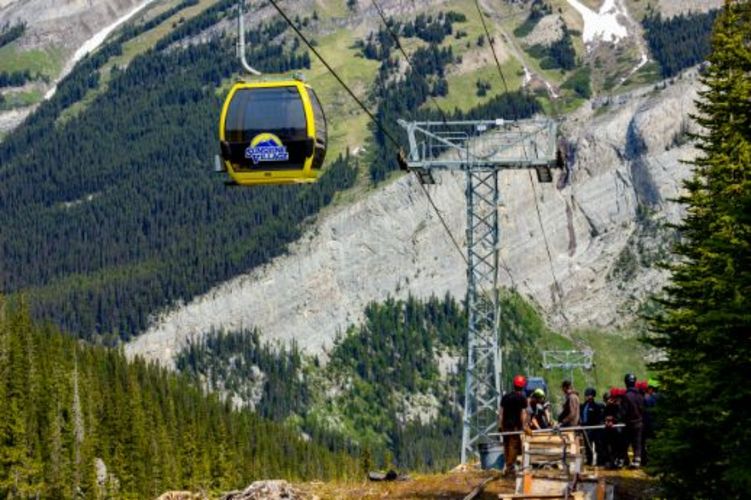Inside the Splice

Inside the Splice: How Sunshine Village Keeps Its Gondola Running Smoothly
At Sunshine Village, ensuring the safety, reliability, and performance of our gondola system is a top priority. This summer, one of the most critical—and fascinating—maintenance procedures took place behind the scenes: the splicing of our gondola haul rope. It’s a rare and highly technical process that doesn’t happen often, but when it does, it’s all hands on deck.
Last week, we welcomed three ropeway experts from Switzerland, flown in by Fatzer—the renowned rope manufacturer. These specialists worked alongside Sunshine Village’s own Gondola Maintenance crew and Mountain Operations team to perform a precision splice on our gondola haul rope. The result? A slightly shorter, more efficient, and more reliable rope system—ready for many seasons to come.
What Is a Gondola Splice?
The haul rope is the backbone of a gondola system. It’s the continuous steel cable that runs in a loop, pulling cabins up and down the mountain. Over time, the rope can stretch slightly due to regular use, tension, and environmental conditions. This stretch, while completely normal, must occasionally be corrected to maintain optimal tension and performance.
That’s where splicing comes in.
A gondola rope splice is the process of reweaving and rejoining the haul rope, effectively shortening it to remove slack caused by years of tension and wear. It’s an intricate task requiring specialized knowledge, absolute precision, and the teamwork of some of the most experienced professionals in the industry.
Why Do We Splice?
While it might seem counterintuitive to shorten the very rope that holds the gondola together, splicing is actually an essential part of long-term gondola maintenance. Over time, even the most robust haul ropes naturally elongate. When the rope becomes too long, it can affect tension levels and overall system performance.
Splicing corrects that elongation, returning the rope to its optimal length and ensuring it remains tight and true across all towers. This helps maintain a smooth ride for guests, reduces wear on mechanical components, and supports the long-term health of the system. In short, a well-executed splice means a safer, smoother, and more efficient gondola ride for everyone.
How Does the Splicing Process Work?
The process began well before our crew arrived on-site. Over several days, our teams coordinated detailed preparations: slowing down the gondola system, clearing cabins, and creating a safe working space. With the system de-tensioned and secured, the rope was carefully marked and measured to identify the correct section to shorten.
Then, the team got to work.
Using specialized tools and hydraulics, the rope was brought to the ground and separated at a precise point. The next step is where the true magic happened—reweaving the rope’s multiple strands back together to form a smooth, continuous section.
Steel haul ropes are made up of hundreds of individual wires twisted into strands, then formed into a cable. During a splice, technicians untwist the ends of each strand, then interlace them back together in a staggered pattern. Each strand is tensioned and woven into its counterpart, ensuring a seamless transition that maintains the rope’s strength and integrity.
It’s a slow and methodical process requiring pinpoint accuracy and years of training. For the Swiss ropeway professionals from Fatzer, it’s second nature—but even for them, it demands full concentration, clear communication, and a shared commitment to safety.
The final stage involved smoothing the splice area and performing a series of thorough inspections. Once approved, the haul rope was re-tensioned, reinstalled onto the towers, and rigorously tested before being brought back online.
The Benefits of a Rope Splice
There are many benefits to splicing a haul rope. First and foremost, it extends the life of the gondola system. By correcting elongation, we reduce unnecessary strain on drive systems, towers, and sheave assemblies—preserving infrastructure and minimizing future maintenance needs.
A properly spliced rope also provides a more consistent and comfortable ride. When the system runs at optimal tension, there’s less vibration and sway, resulting in a better experience for guests.
Splicing also provides a rare opportunity to inspect the rope’s internal structure—something not possible during regular maintenance. It allows us to detect potential weaknesses or corrosion and address them proactively before they become issues.
A Shared Effort of Excellence
At Sunshine Village, we’re proud of the collaborative spirit that keeps our mountain running. The gondola splice was no exception. Watching our in-house experts work shoulder to shoulder with Fatzer’s seasoned technicians was a powerful reminder of the international community that supports alpine operations. It’s a testament to our ongoing commitment to safety, precision, and innovation.
As we look ahead to another exciting summer hiking season and the snowy months beyond, our freshly spliced gondola rope stands ready to carry guests smoothly from the base area to the village and beyond. It’s not just a cable—it’s a symbol of the behind-the-scenes dedication that powers every Sunshine adventure.
So the next time you step into a gondola cabin and glide effortlessly up the mountain, know that a team of global experts—and one very carefully crafted splice—helped make that ride possible.
